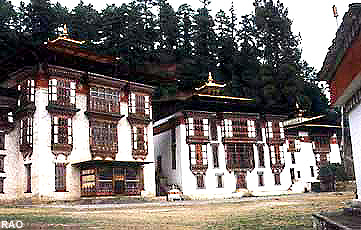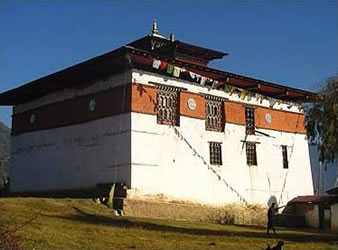|
Bhutanese
Achitecture -Different types of buildings
|
 |
Kurjey Lhakhang near Jakar, Bumthang
| Temples
are usually one or two-storied buildings with a wide red stripe at the
upper level of the walls and a gilded roof ornament. A small courtyard
may be enclosed in the walls with the residence of the lame attached to
it.Inside, the ceiling is supported by pillars, which divide the space
into a shrine and an antechamber, and the walls are covered with paintings.
The altar occupies one side of the shrine with the other side usually devoted
to protective deities. |
|
The
rest of the space is left empty to be used by devotees for performance
of rituals. Many temples are also housed in monasteries and dzongs.
|
Goenpa
/ Gompa (Monasteries) |
 |
The
monasteries are of two types:
 The
cluster type is probably more ancient. It consists of one or two temples
housed in a building and surrounded by small houses, which serve as living
or meditation quarters for the monks. Some examples of the cluster type
are Dzongdrakha in the Paro valley, Dodedra, Phajoding, Chari and Trashigang
nunnery in the Thimphu region, Kuenzangdra and Tharpaling in the Bumthang
region as well as most of the monasteries in the eastern region. The
cluster type is probably more ancient. It consists of one or two temples
housed in a building and surrounded by small houses, which serve as living
or meditation quarters for the monks. Some examples of the cluster type
are Dzongdrakha in the Paro valley, Dodedra, Phajoding, Chari and Trashigang
nunnery in the Thimphu region, Kuenzangdra and Tharpaling in the Bumthang
region as well as most of the monasteries in the eastern region.
|
 The
dzong type is a monastery built like a fortress with a main tower, housing
many temples and a surrounding outer structure which provides accommodation
for the monks. The most impressive examples of this type are Tango in the
upper Thimphu valley, Talo in Punakha, Gangtey Goemba near Pelela and Dramitse
in eastern Bhutan. The
dzong type is a monastery built like a fortress with a main tower, housing
many temples and a surrounding outer structure which provides accommodation
for the monks. The most impressive examples of this type are Tango in the
upper Thimphu valley, Talo in Punakha, Gangtey Goemba near Pelela and Dramitse
in eastern Bhutan.
|





![]() The
dzong type is a monastery built like a fortress with a main tower, housing
many temples and a surrounding outer structure which provides accommodation
for the monks. The most impressive examples of this type are Tango in the
upper Thimphu valley, Talo in Punakha, Gangtey Goemba near Pelela and Dramitse
in eastern Bhutan.
The
dzong type is a monastery built like a fortress with a main tower, housing
many temples and a surrounding outer structure which provides accommodation
for the monks. The most impressive examples of this type are Tango in the
upper Thimphu valley, Talo in Punakha, Gangtey Goemba near Pelela and Dramitse
in eastern Bhutan.